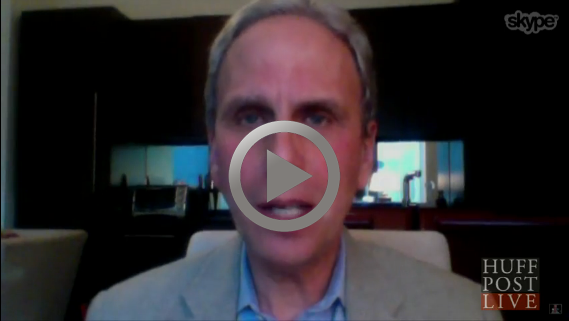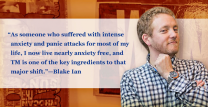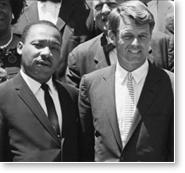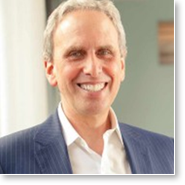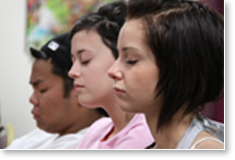 The following appeared on September 30th on Maria Shriver’s website in a section devoted to “Architects of Change.” It was written by Bob Roth, the Executive Director of the David Lynch Foundation for Consciousness-Based Education and World Peace.
The following appeared on September 30th on Maria Shriver’s website in a section devoted to “Architects of Change.” It was written by Bob Roth, the Executive Director of the David Lynch Foundation for Consciousness-Based Education and World Peace.
INSPIRATIONAL STORIES from ARCHITECTS of CHANGE
I grew up in the San Francisco Bay Area in the 1950s and ’60s, in a very political family. So political, in fact, that I (literally) knew I was a Democrat before I knew I was Jewish.
I was raised in a home where Civil Rights, the Vietnam War and the Cold War were all topics of discussion (not really debate, we all agreed on the basics) around the dinner table. My parents imbued within all four of us kids a deep, passionate desire to do something good for the world—and from that upbringing, I knew early on as a high school student that I wanted to go into politics. Ultimately, I saw myself as a U.S. senator. My passion gained urgency after experiencing the traumas of 1968 and the assassination of Martin Luther King, Jr. and the terrible murder of Robert F. Kennedy, whose presidential campaign I had worked for during my senior year in high school.
I graduated high school in June 1968 and entered the University of California at Berkeley in the Fall, overwhelmed, naive, unsuspecting of the shocking developments that my life would take in that first year: demonstrations and riots on Telegraph Avenue, helicopters spewing tear gas over thousands of students assembled at Sproul Plaza, the site of huge sit-ins against the war; Army tanks (yes, tanks) parked outside the front door of my house; and two young people gunned down over the property rights of rock-strewn vacant lot known as “People’s Park.”
Those were crazy times and my love for politics as a chosen profession began to erode with the polarizing divisiveness, violence and abuse of the day, which I witnessed firsthand. I found a growing interest in education, where I would, I told my confused father, get a doctorate with a focus on curriculum development. I would help change the world starting with kindergarteners.
I was not a hippie, I did not take drugs and I was not interested in the plethora of new sects and new age philosophies that were sweeping through town. But I was disoriented and stressed. Really stressed. I had a part-time job at a Swenson’s ice cream store—the only job I could find that fit my class schedule. And amidst all the clean-cuts and longhairs and jocks and crazies that either worked or frequented that store there was one guy I worked with, Peter Stevens, who was like a calm reflecting pool. Peter was centered, energetic, super-smart, kind to all, easy going, never agitated, with an ineffable calm about him. I found out, rather serendipitously that he “meditated.” It sounded discordant to me. In my activist-centric world of “If you are not part of the solution you are part of the problem,” meditation was not in my vocabulary. But I was intrigued and curious, and then grew open when he told me there was nothing to believe in. And equally attractive to my busy, busy mind: he assured me it was simple, easy, and I could actually do it.
Cautiously but bravely (I had never gone to learn something like meditation before), I attended an introductory talk on the technique. A nice, well-dressed man spoke for about 45 minutes. He said a few things that struck me. He said the Transcendental Meditation technique gave the experience of a deeply settled, peaceful state of awareness that already existed at all times deep within the thinking mind of everyone.
He said there were marked physiological changes and health benefits to the practice. He said that the TM technique was an easy, effortless practice, unlike other meditations, which required extraordinary powers of concentration to calm the mind. He said I did not have to believe in anything for it to work. And he said something that resonated with my egalitarian soul: everyone can do it as well as everyone else—no one does it better or worse than anyone. As human beings, are all equally hardwired for the experience. The meditative experience is our birthright.
I learned to meditate, not out of a book or in a group, but one-to-one, from a specially trained teacher in quiet room off the hallway of the Berkeley TM center. My memories of that first experience of meditation remain clear. It was physical. Within moments, I had the physical sensation of sinking, deeply, into a vast inner calmness. I was awake and yet the muscles in my body loosened immediately.
I experienced, very concretely, something different than I had ever known, a sensation of diving vertically “within.” It was unique to my usual horizontal sampling of life, skimming on the surface, from one sensory experience to the next. While new, it was not at all foreign; rather it was comforting, natural, and somehow very familiar.
It was clear from my first experience that TM was “something,” most definitely something. It was not just “thinking” about being calm, or “visualizing” being calm or “trying” to be calm. I entered “calm.” I later learned from my teacher that everyone has different experiences in their first meditations. I also learned that every meditation in Transcendental Meditation will be different—not based on the ability to practice the technique correctly, but rather based on the condition of the body, be it rested, exhausted, stretched by demands, in mid-digestion, etc.
Needless to say, I loved it. I loved the ease, the naturalness, and the access I had to an inner “me” I never knew existed. I finished my first meditation feeling renewed from the core of my Being. I was grateful. I had the thought that I would like to share this with others; more specifically, considering my education major, I would like to teach this to kids. My first experiences were quite good, and yet, even so, to my surprise, I stayed with it. (I mean I was an 18-year-old student at UC Berkeley and I didn’t do anything every day, including study, much less sit quietly for 20 minutes.)
I continued to meditate, twice a day, every day, for three years, through disjointed freshman, sophomore and junior years, when it seemed like classes at the university were being shut down in strikes against the Vietnam War as often as not; when politics continued to fade from memory as my personal, chosen path to affect change.
Slowly the thought transformed itself into a conviction: I should teach this. I could help make change, in myself and in the world, through a meditation practice devoid of philosophy, dogma, or boundaries. Suddenly, what I felt compelled to do was no longer restricted to ensuring voter rights or marches against the war or arguing causes in a political arena—all essential causes, to be sure. But they would no longer be my sole passion.I now wanted to learn to teach a meditation that could give access to the vast untapped, regenerative resources that lay dormant, just beneath the crazy busyness of the thinking mind.
With the okay from my parents, in 1972 I took a semester off from college, traveled to Spain, studied with Maharishi, the Indian physicist who had himself studied with the greatest meditation teacher of his time, Guru Dev, in order to become a “Maharishi” (great teacher) and bring Transcendental Meditation to the world.
After nearly six months of study with Maharishi, I became a TM teacher. The profession fit me perfectly. I lectured and taught TM to thousands of people all over the world during the next 30 or 40 years—in businesses, hospitals, schools and universities, on military bases, prisons, and shelters. I loved every minute of it.
Fast forward to 2005 when, through a series of “happy accidents” (as he would call them), I joined with filmmaker David Lynch to launch the David Lynch Foundation for Consciousness-Based Education and World Peace. Our goal: to raise the funds to provide scholarships for any child in America who wanted to learn to meditate.
With the support of so many, we gained our 501(c)(3) nonprofit status, embarked on fundraising initiatives and today, while not nearly where we want to be, nevertheless, we have grown dizzyingly fast, globally, and are so much farther along than I ever imagined.
To date, we have provided scholarships for over 300,000 at-risk students in underserved schools in 35 countries to learn to meditate; we are working with the Veterans Administration, the Department of Defense, and the Wounded Warrior Project to bring the Transcendental Meditation technique to tens of thousands of veterans and their families who suffer from post-traumatic stress disorder; and we are partnering with the Family Justice Centers and other similar organizations nationwide to teach the TM technique to women and children who have been victims of domestic violence.
I feel the tipping point has tipped with regard to the public’s understanding and appreciation for the value of meditation, in general, and the Transcendental Meditation technique, specifically. There is openness and a receptivity that I have not seen in the past 40 years of teaching.
It feels like something foundational can be done to help transform lives through meditation, not only among those most at-risk to suffer traumas in life, but also the teen in the private school who battles the very real demons of substance abuse and unspoken thoughts of suicide; the parent who is struggling to survive an ugly divorce and still keep the family intact; or just the person—man, woman, boy, girl—who is navigating life’s daily vicissitudes and can’t seem to catch a breath, turn off the noise, get a good night’s sleep.
With all of this, after 40 years of teaching the TM technique, I feel myself coming full circle: I feel an energy and idealism that I have not known since those heady days in early 1968, before the bloodshed crushed my soul, that I, along with a whole lot of smart, inspired, impassioned people, can do something significant and sustainable to make the world a far better place for a whole lot of other people, from the inside out.
For more information about the good works of the David Lynch Foundation, please visit www.DavidLynchFoundation.org.
ABOUT THE AUTHOR
_____________________________________________________________________________________________________
Bob Roth is the Executive Director of the David Lynch Foundation, where he has helped to direct the introduction of the Transcendental Meditation (TM) program to over 300,000 at-risk students in 35 countries, veterans with post-traumatic stress disorder, and women and girls who are survivors of domestic violence. He also serves as national director of the Center for Leadership Performance, where he helped to oversee the introduction of the TM program in business, industry and governmental organizations. Mr. Roth has been practicing Transcendental Meditation for 45 years and a teacher of the technique for over 40 years. He lives in New York City.
